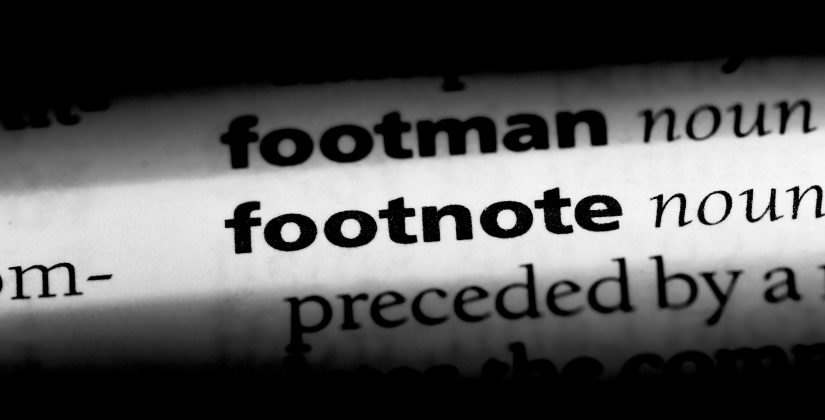Judges take note: but are we dragging our feet when we should be toeing the line?
Elijah Granet discusses the advantages of using footnotes for citations of case law in judgments, in common with other common law jurisdictions. … Continue reading

The coronavirus pandemic has prompted enormous and epochal shifts in courts and the legal profession (alongside virtually every other area of society). Amidst all these big changes, I would like to propose a very little one: the English & Welsh courts should adopt the practice of their Commonwealth counterparts and start using footnotes in judgments.
A common law court judgment necessarily involves an enormous quantity of citations to precedent, accompanied by occasional forays into law journals and books. While academic legal writing almost universally uses footnotes to talk these citations into a neat column at the bottom of the page, this jurisdiction’s courts continue to print the citation in full, in running text. This can take up an enormous amount of space, particularly if one cites a case with multiple reports and a long name, such as the alliterative Featherstonhaugh v Fenwick (1810) 17 Ves Jun 298; 34 ER 115. If a judge wants to refer to a long line of case law, the flow of the judgment must be visually paused in order for the roll of citations to be printed out. When footnotes are used properly—and here the advice of the American typographer and lawyer Matthew Butterick on proper use of footnotes is invaluable—they allow citations and text to each repose in their proper place, enabling the reader to consult each in the best format possible.
Although the presentation of the law is certainly important (as an indicator of the dignity and majesty of the institution), my passion for footnotes in judgments is more than aesthetic. Legal citations, at their best, are precise routing instructions, guiding the reader at every point with efficiency and ease to the location of the cited passage. This is why ICLR reports sub-divide not merely into pages, but into parts of the page. For example, [1977] 1 WLR 766, 783F shows the reader exactly on what part on page 783 the passage occurs. Footnotes are perfect tools for internal pinpointing —ie they allow a reader to be efficiently told where in a judgment a case was first mentioned. Thus, instead of (as has to occur in England & Wales) having to search the document for the first mention of a case, the reader of (say) a New Zealand judgment can see, by the addition ‘Anderson, n 4’ that the case of Anderson was first mentioned at footnote 4. This little added efficiency is a boon to time-pressed lawyers reading through stacks of judgments when preparing a case.
Furthermore, footnotes also inform the reader of the context of the page at hand. ICLR reports begin each judgment with a list of cases and statutes cited. This intellectual map shows the range and extent of precedent cited, and informs the background a reader needs to understand a case. Footnotes provide this same map for every page, by providing, at the foot, a list of all authorities referenced on that page. Once again, this little added efficiency is a welcome boon to those having to navigate an enormous pile of PDFs when preparing for a case.
It is true that historically, in an era before word processing, footnotes in judgments could be technologically difficult. Today, adding footnotes to a document is trivially easy. English & Welsh judges already include discursive (rather than citing) footnotes in the text of their decisions, and BAILII features these without issue. HTML footnotes are widely used in scholarly work (such as Cambridge University Press’s HTML versions of books), and, as simple creatures of hypertext, pose no barriers to entry for those with older browsers or laptops, nor confuse screen-reading software used by those with visual impairment. The proof of the smooth-working of this is BAILII’s antipodean counterpart, AUSTLII, which seamlessly integrates footnotes into its HTML judgments.
Finally, by dragging its feet (no pun intended) on footnotes, this jurisdiction is also falling behind its counterparts in the common law world. While the UK Supreme Court still uses running text citations, the High Court of Australia, the New Zealand and Indian Supreme Courts, and the Constitutional Court of South Africa all use footnotes. The Supreme Court of Canada does not, but that court has to contend with bilingual texts for all its judgments, which means that it faces technological challenges which simply do not apply to this jurisdiction. The United States Supreme Court also continues to use running-text citations, but that court does not even number its paragraphs, suggesting that it is content to remain behind global trends. The widespread adoption of the practice suggests that other jurisdictions have perceived the same advantages conferred by the use of footnotes.
This is, admittedly, a small issue given ongoing events. Switching to footnotes won’t reshape the future of law, like remote hearings or digitalisation may. Yet, equally, for the reasons discussed above, jumping to footnotes makes good sense. The improvement to our legal system caused by switching to footnotes may be relatively trivial, but it will certainly be an improvement. At a time when many aspects of the legal system are approaching breaking-point, it is submitted that any improvement, however small, is to be eagerly welcomed.
Elijah Granet is a PhD candidate in Law at Universität Bayreuth, and an alumnus of the City Law School’s Graduate Diploma in Law. Outside the law, Elijah enjoys fencing, occasionally appearing on quiz shows, and thinking of third items in lists. He blogs at ezgranet.com.
[Editor’s note: ICLR house style currently uses footnotes for legislation references in the headnote of our law reports, and endnotes on the rare occasions when footnotes are found in reported judgments. These are hyperlinked online.]
Featured image: footnote concept via Shutterstock